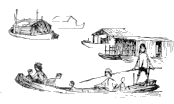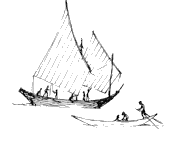|
Sailing in a Plaited Bamboo Boat |
| Did you ever hear of a bamboo basket for holding water? Then learn of
the Vietnamese who make and use boats of plaited bamboo to travel
canals, rivers, and the sea--for harvesting the crops, for
transportation of the family, or for catching the fish which provide the
basic protein of the Vietnamese diet.
According to a Vietnamese book, HAI DUONG CANG CHI, it was a military commander--Tran Ung Long--who invented this unique boat of plaited bamboo in about 975 A.D. In pursuit of an enemy, he came to a river, only to discover that all the boats had been destroyed. Determined to capture his foe, and having observed how some of the Vietnamese fishermen could actually walk on water in plaited bamboo baskets, he ordered that bamboo be secured and boats built. But when these boats were placed in the water, they quickly sank. He then ordered his troops to search for a natural lacquer which would act as a varnish and water proofing for the bamboo, When this was accomplished by the use of a forest resin, victory was the result. Later as the political tide changed, Tran Ung Long resigned and spent the rest of his life as a plaited bamboo boat builder.
The warm tropical waters in this area are filled with teredowood worms, mollusks and other marine life which can readily destroy untreated boat bottoms. While sao-wood makes good sides for the hull, these forms of sea life would quickly ruin the boat bottoms. The Vietnamese discovered that bamboo, being strong, light, flexible and tough, resists the assaults of sea life, especially when treated with a resin binder. Moreover the flexible bamboo bottom allows boats to squeeze into shallow waters. They can shift sufficiently to allow passage into otherwise impassable areas.
In areas where a wooden hull might be dangerous, unwise or unworkable, the bamboo bottom works well. When grounded, the flexible bottom absorbs the shock and, by spreading out, allows the boat to continue on its way. The low cost and simple construction permits replacement as frequently as necessary while the sides of the hull may stay usable for many years. Some Americans serving as Junk Force advisers, have found that the Viet Cong utilize such craft. By this means they are sometimes able to escape from the rigid-frame boats in the shallow waters of the delta, much to American dismay and disappointment. If engines are mounted on these boats, care has to be taken to spring-mount them to prevent the vibrations from causing the bamboo to spring leaks. Mounting with a long drive shaft gives these craft maneuverability as well as speed. Because bamboo is used in so many important ways by the Vietnamese, there is little wonder that they like to feel that they reflect its tough resiliency and effectiveness in their personal lives. Courtesy of the 1967 USMC Unit Leaders Personal Response Handbook
|
 Anyone visiting Vietnam today will see literally tens of thousands of
these craft that range in size from the one-man, round, bowl-like craft
to the larger junks that run regularly along the coastlines and rivers.
Each of the small craft seen in this country has been developed to meet
varying geographical circumstances of tides, winds, surf conditions,
water depths, etc. Due to the extensive irrigation system, the smaller
ones can even be used to carry rice from the fields to the storage
areas.
Anyone visiting Vietnam today will see literally tens of thousands of
these craft that range in size from the one-man, round, bowl-like craft
to the larger junks that run regularly along the coastlines and rivers.
Each of the small craft seen in this country has been developed to meet
varying geographical circumstances of tides, winds, surf conditions,
water depths, etc. Due to the extensive irrigation system, the smaller
ones can even be used to carry rice from the fields to the storage
areas. The bottomless wooden sideboards are fitted into a basket made of
strips of bamboo woven into a watertight construction and kept in shape
by long flexible bamboo stringers. The solid sides and the bamboo bottom
are fitted together with longitudinal gussets to form the hull of the
boat. Removable boards form a false deck for working space and allow the
transportation of rice, produce and people. These strange craft may run
up to 14 tons gross weight or be just large enough for one person.
The bottomless wooden sideboards are fitted into a basket made of
strips of bamboo woven into a watertight construction and kept in shape
by long flexible bamboo stringers. The solid sides and the bamboo bottom
are fitted together with longitudinal gussets to form the hull of the
boat. Removable boards form a false deck for working space and allow the
transportation of rice, produce and people. These strange craft may run
up to 14 tons gross weight or be just large enough for one person.